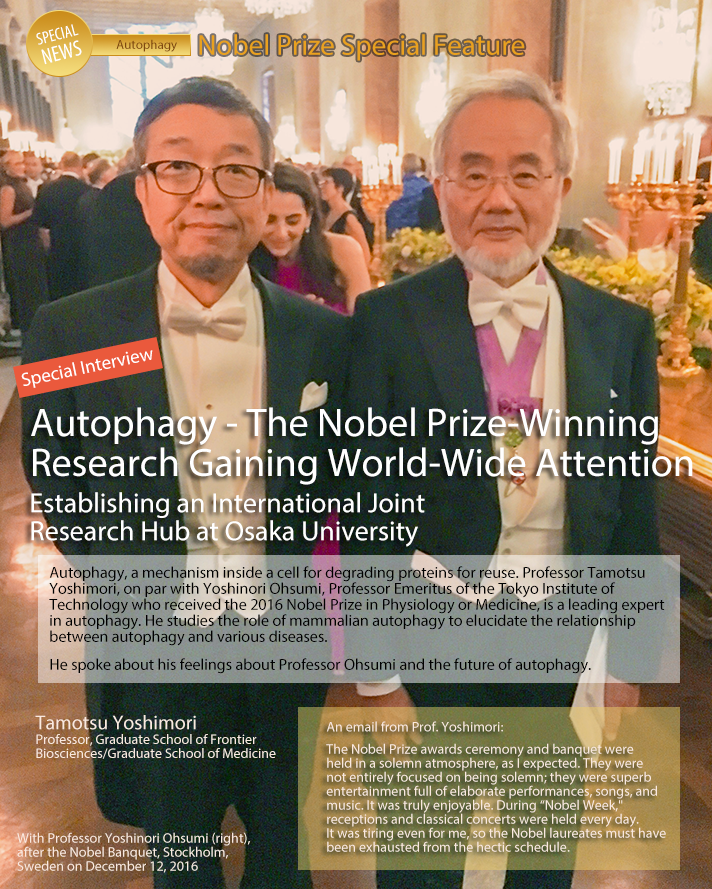
"Autophagy"- The Nobel Prize-Winning Research Gaining World-Wide Publicity
Professor Ohsumi’s award gives momentum to autophagy research
Prof. Yoshimori and Prof. Ohsumi had previously performed research together at the National Institute for Basic Biology in Okazaki, Aichi. (See NewsLetter No. 67 .) Hearing the news about Prof. Ohsumi’s Nobel Prize, Prof. Yoshimori was delighted, saying, "I assumed that this would eventually happen. It was my dream, too." It was three weeks after the announcement of Nobel laureates that Prof. Yoshimori met Prof. Ohsumi. Prof. Yoshimori said, "He looked very busy with dealing with the press, but he acted normally, saying, 'I won't change regardless of whether I won the prize or not.' We didn’t talk about research."
On why Prof. Ohsumi won the prize, Prof. Yoshimori says, "His discovery of related genes with yeast in 1993 was very important." Actually, the phenomenon of autophagy was discovered in the 1960s, but it was difficult to examine under the technology at that time. However, Professor Ohsumi elucidated the mechanism of autophagy in yeast for the first time, which greatly accelerated autography research. Currently, it is thought that impaired autophagic function causes intractable neurological diseases such as Parkinson’s disease, Alzheimer’s disease, and diabetes. He smiled, saying, "Professor Ohsumi’s award gives momentum to autophagy research."

Establishing an Autophagy Center that mediates Basic Research and Clinical Applications
Continuing his research at Osaka University, in 2015, Prof. Yoshimori established the “Autophagy Center” that mediates basic research and clinical applications in the Graduate School of Medicine in anticipation of a wide range of clinical applications. In collaboration with a number of clinical research departments of gastroenterology and immunity allergy, this center studies the relationship between autophagy and diseases.
In September of 2016, in experiments with mice, his group revealed that fatty liver disease, a lifestyle disease, was caused by overexpressed Rubicon protein that inhibits autophagy. Rubicon may be a novel therapeutic target for controlling fatty liver disease.

Clarifying the mechanism of autophagy-related diseases
"Our next challenge is to clarify the mechanism behind autophagy-related diseases," said Prof. Yoshimori. “Since autophagy is a fundamental cellular function, clarification of the mechanism will lead to effective treatments for various diseases." This center will play an increasingly significant role in this field.
"There are no other research institutes to study autophagy through collaboration between basic research and clinical applications. I want Osaka University to take the initiative in autophagy research and make it a hub for international collaborative research." He excitedly spoke.

 Tamotsu Yoshimori
Tamotsu Yoshimori
A 1981 graduate of the School of Science, Osaka University, Prof. Yoshimori left the doctoral course at the Graduate School of Medicine.
After serving as an assistant at Kansai Medical University, an assistant professor of National Institute for Basic Biology, and a professor of National Institute of Genetics, in 2006, he became a professor at the Research Institute for Microbial Diseases, Osaka University.
In 2009, he became Professor at the Graduate School of Frontier Biosciences and the Graduate School of Medicine, and in 2015, he and Professor Noboru Mizushima of The University of Tokyo won the Uehara Prize for their work in the field of “molecular structure and physiology of the mammalian autophagy”.
Prof. Yoshimori has also received the MEXT Minister Prize for Science and Technology and was recognized as one of the Thomson Reuters "The World’s Most Influential Scientific Minds (Highly Cited Researchers)."